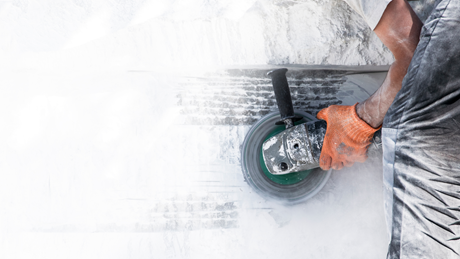Prevent & Protect Against Silicosis
blog 04 Mar 2024
It is no secret that lung disease stands as one of the most prolific health conditions in the UK today, so much in fact that when the NHS set out their Long-Term Plan back in 2019, they recognised combatting lung disease as a clinical priority moving forward[1]. However, many lung diseases currently exist without a cure, meaning the emphasis on prevention is paramount.

Silicosis
One commonly overlooked form of lung disease is Silicosis, which arises by inhaling a substance called silica. Silica itself is a chemical compound that makes up 59% of the world’s crust, meaning it is extremely prevalent in natural rocks, sand and clay, as well as in construction materials such as bricks, tiles and mortar.[2]
Undisturbed, silica does not pose a significant threat to human health, but once materials containing silica are cut or grinded, a crystalline silica (RCS) dust is released which could then be inhaled by anybody in the vicinity if they are not provided with the correct respiratory protective equipment (RPE). With that in mind, there is no need to be overly cautious of the bricks holding up your house or the paving stones in your garden if they are lying there static, however in settings where disturbing these materials is common, there should be a heightened awareness of the potential dangers.
Live monitoring to combat occupational silicosis
Considering silica’s prevalence in common materials used in industries such as construction or the stone industry, the risk of occupational silicosis is astronomical. So much in fact that globally it is estimated that 40 to 50 million workers are exposed to silica dust in the workplace every year.[3]
So, how can we best combat occupational silicosis?
“If we are going to combat silicosis as a society, we believe we need to understand what is happening in the moment in order to take the best actions (prevent, control, protect) against this invisible killer. Gone are the days of waiting weeks to find out if exposure levels were too high, we now live in a world where every minute can tell a story about the level of exposure and its cause, combatting silicosis starts with real-time data, educating the best decisions.”
- Steve Holland, Trolex Managing Director
Trolex Technical Product Manager, Adrian Eccles added: “Silica dust is too fine to see and if you can’t see it, how do you know what people are breathing in? Luckily, our Air XS Silica Monitor can warn you instantly when unsafe dust levels occur, allowing you to take action to keep people safe.”
Live monitoring on my site
Despite sites across the UK already taking an active approach to monitoring for these harmful substances, the protocols must continue to remain in line with new innovative technologies to give them the best chance of successful prevention. In many instances retrospective monitoring is the predominant approach, which does prove useful in its own right but it simply captures a snapshot in time. Whereas by moving to a live monitoring capability, sites are able to measure exposure levels in real-time and be guided by the data to moderate activity if exposure levels reach beyond safe regulatory thresholds.
So, how can those industries who have already taken the step towards live monitoring set a blueprint for others?
“Like with any major industrial advancement, early adopters are vital in providing products like the Trolex Air XS with a platform to showcase their effectiveness in real-life scenarios. Fortunately, we have recently seen organisations like the Central Rail Systems Alliance and Balfour Beatty step up to include these technologies on their sites to record prevalence rates and validate the introduction of further preventative measures. These steps act as a slipstream for other organisations to follow and demonstrate the positive results they can expect if they onboard live monitoring as a capability on their site.
At Sunbelt Rentals we are proud to be a preferred supplier of such groundbreaking technologies for the market to take advantage of and are delighted to be involved in helping organisations mould their future health and safety protocols to include the prevention of harmful particulate inhalation.”
- Perry Jones, Test and Monitoring National Business Development Director
The strategy moving forward
As new technologies emerge and capabilities advance, sites must continue to pursue education and adopt the latest advancements where possible to best protect their workforce from occupational silicosis. With that said, there is an even greater emphasis on the test and monitoring industry as a whole to continue to spread awareness of new innovative solutions like the Trolex Air XS and contextualise to organisations the dangers that can be mitigated by onboarding a product like this.
To find out more about how you can elevate your site’s test and monitoring capabilities, visit our dedicated Test and Monitoring e-commerce website where tools like the Trolex Air XS are available for immediate hire. Alternatively, you can contact environmental@sunbeltrentals.co.uk for more information from one of our experts.
[1] NHS Long Term Plan v1.2 August 2019

 Open your account online within 24 hours
Open your account online within 24 hours  Nationwide, next day delivery available
Nationwide, next day delivery available  Over 200 locations near you
Over 200 locations near you